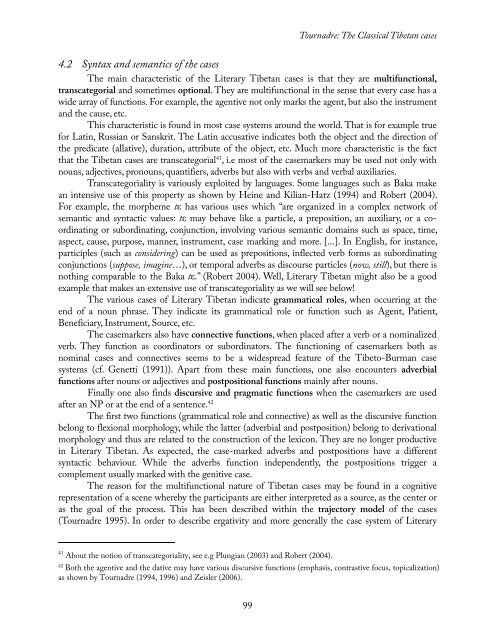The Classical Tibetan cases and their transcategoriality
The Classical Tibetan cases and their transcategoriality
The Classical Tibetan cases and their transcategoriality
You also want an ePaper? Increase the reach of your titles
YUMPU automatically turns print PDFs into web optimized ePapers that Google loves.
99<br />
Tournadre: <strong>The</strong> <strong>Classical</strong> <strong>Tibetan</strong> <strong>cases</strong><br />
4.2 Syntax <strong>and</strong> semantics of the <strong>cases</strong><br />
<strong>The</strong> main characteristic of the Literary <strong>Tibetan</strong> <strong>cases</strong> is that they are multifunctional,<br />
transcategorial <strong>and</strong> sometimes optional. <strong>The</strong>y are multifunctional in the sense that every case has a<br />
wide array of functions. For example, the agentive not only marks the agent, but also the instrument<br />
<strong>and</strong> the cause, etc.<br />
This characteristic is found in most case systems around the world. That is for example true<br />
for Latin, Russian or Sanskrit. <strong>The</strong> Latin accusative indicates both the object <strong>and</strong> the direction of<br />
the predicate (allative), duration, attribute of the object, etc. Much more characteristic is the fact<br />
that the <strong>Tibetan</strong> <strong>cases</strong> are transcategorial 41 , i.e most of the casemarkers may be used not only with<br />
nouns, adjectives, pronouns, quantifiers, adverbs but also with verbs <strong>and</strong> verbal auxiliaries.<br />
Transcategoriality is variously exploited by languages. Some languages such as Baka make<br />
an intensive use of this property as shown by Heine <strong>and</strong> Kilian-Hatz (1994) <strong>and</strong> Robert (2004).<br />
For example, the morpheme tε has various uses which “are organized in a complex network of<br />
semantic <strong>and</strong> syntactic values: tε may behave like a particle, a preposition, an auxiliary, or a coordinating<br />
or subordinating, conjunction, involving various semantic domains such as space, time,<br />
aspect, cause, purpose, manner, instrument, case marking <strong>and</strong> more. [...]. In English, for instance,<br />
participles (such as considering) can be used as prepositions, inflected verb forms as subordinating<br />
conjunctions (suppose, imagine…), or temporal adverbs as discourse particles (now, still), but there is<br />
nothing comparable to the Baka tε.” (Robert 2004). Well, Literary <strong>Tibetan</strong> might also be a good<br />
example that makes an extensive use of <strong>transcategoriality</strong> as we will see below!<br />
<strong>The</strong> various <strong>cases</strong> of Literary <strong>Tibetan</strong> indicate grammatical roles, when occurring at the<br />
end of a noun phrase. <strong>The</strong>y indicate its grammatical role or function such as Agent, Patient,<br />
Beneficiary, Instrument, Source, etc.<br />
<strong>The</strong> casemarkers also have connective functions, when placed after a verb or a nominalized<br />
verb. <strong>The</strong>y function as coordinators or subordinators. <strong>The</strong> functioning of casemarkers both as<br />
nominal <strong>cases</strong> <strong>and</strong> connectives seems to be a widespread feature of the Tibeto-Burman case<br />
systems (cf. Genetti (1991)). Apart from these main functions, one also encounters adverbial<br />
functions after nouns or adjectives <strong>and</strong> postpositional functions mainly after nouns.<br />
Finally one also finds discursive <strong>and</strong> pragmatic functions when the casemarkers are used<br />
after an NP or at the end of a sentence. 42<br />
<strong>The</strong> first two functions (grammatical role <strong>and</strong> connective) as well as the discursive function<br />
belong to flexional morphology, while the latter (adverbial <strong>and</strong> postposition) belong to derivational<br />
morphology <strong>and</strong> thus are related to the construction of the lexicon. <strong>The</strong>y are no longer productive<br />
in Literary <strong>Tibetan</strong>. As expected, the case-marked adverbs <strong>and</strong> postpositions have a different<br />
syntactic behaviour. While the adverbs function independently, the postpositions trigger a<br />
complement usually marked with the genitive case.<br />
<strong>The</strong> reason for the multifunctional nature of <strong>Tibetan</strong> <strong>cases</strong> may be found in a cognitive<br />
representation of a scene whereby the participants are either interpreted as a source, as the center or<br />
as the goal of the process. This has been described within the trajectory model of the <strong>cases</strong><br />
(Tournadre 1995). In order to describe ergativity <strong>and</strong> more generally the case system of Literary<br />
41<br />
About the notion of <strong>transcategoriality</strong>, see e.g Plungian (2003) <strong>and</strong> Robert (2004).<br />
42 Both the agentive <strong>and</strong> the dative may have various discursive functions (emphasis, contrastive focus, topicalization)<br />
as shown by Tournadre (1994, 1996) <strong>and</strong> Zeisler (2006).
















